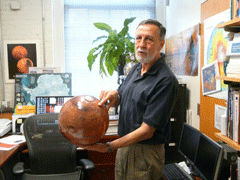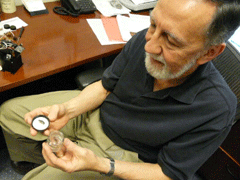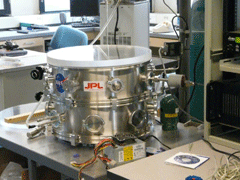Searching for Life on the Red Planet
Air Date: Week of May 23, 2008

Samuel Kounaves holds a globe of the Red Planet. (Photo: Bruce Gellerman)
NASA’s latest mission to Mars is set to land on the red planet this week in search of evidence that the planet can support life. Tufts University extreme chemist, Dr. Sam Kounaves, built the “laboratory in a teacup” that will test the frozen martian soil. Living on Earth host Bruce Gellerman stopped by the Tuft’s lab for a close encounter.
Transcript
[MAN COUNTS DOWN 'T MINUS TEN, NINE, EIGHT…']
GELLERMAN: AUGUST 4, 2007, Cape Canaveral Florida.
[SIX, FIVE…]
GELLERMAN: NASA’S Phoenix Mission to Mars is poised to begin.
[MAIN ENGINES START, TWO, ONE, ZERO AND LIFTOFF OF THE DELTA II ROCKET WITH PHEONIX, A DISTANT SCIENCE OUTPOST SEEKING CLUES OF THE EVOLUTION AT THE POLAR REGION OF MARS]
GELLERMAN: Four hundred twenty one million miles and ten months later, the Phoenix Mars Lander is scheduled to set down near the North Pole of the red planet this week.
We’ve been sending missions to Mars’ surface for more than 30 years. Mars, on the other hand, has been visiting us for time immemorable. Not tiny green men, but rocks. You can find one in Sam Kounaves’s office at Tufts University. Professor Kounaves keeps it in a small glass bottle labeled ‘Shergottite.’
KOUNAVES: We do have a little nugget from Mars actually.
GELLERMAN: Let me just see.
KOUNAVES: Well, it’s a piece of Mars.
GELLERMAN: Martian meteorite –
KOUNAVES: Sample

Mars Mission Co-Investigator Samuel Kounaves looks at a sample of a Martian meteorite found in Antarctica. (Photo: Bruce Gellerman)
KOUNAVES: So, many years ago, it was discovered that some of the meteorites that had been picked up in Antarctica were actually from a planet. It was a terrestrial planet, and there’s a crust on the outside here – that’s the fusion crust – so you know a meteorite because it comes through the atmosphere, and it burns the outside of the meteorite. So they found in this meteorite little glass bubbles that have sealed who knows how long ago, and in those glass bubbles was gas, and the gas matched Mars’ atmosphere exactly.
GELLERMAN: Can I touch it?
KOUNAVES: Well, no we try not to touch it. (laughs)
GELLERMAN: I can’t touch it. Whoa, but this is about as close to Mars as I’m gonna get.
[FOOTSTEPS]
GELLERMAN: Actually, Mars was a lot closer than I thought. You can find it in a lab just down the hall from Kounaves’s office.
[DOOR CREAKS OPEN; KOUNAVES SAYS ‘THREE OF MY PEOPLE WHO WORK HERE ARE NOT HERE…’]
KOUNAVES: This is our Mars Chamber. This is – we use this to test some of the instruments and also do experiments on Mars soil at Mars conditions. So inside here we generate the atmosphere of Mars at the pressure of Mars and also the temperature that it is on Mars. So what we have is a mini-Mars here.
GELLERMAN: It looks like an autoclave. It’s got a lot of, you know, valves.
KOUNAVES: Yeah. Let me see if it’s still on here, if I could turn this –
[MARS CHAMBER SWITCHED ON; MOTOR STARTS UP]
KOUNAVES: So right now what it’s doing is it’s making it like Mars in there. We won’t go all the way, it takes about half an hour to get everything just right.

The Mars Chamber can simulate atmospheric conditions found on Mars. (Photo: Bruce Gellerman)
GELLERMAN: Why Mars? Why do you think of going to Mars?
KOUNAVES: Well actually Mars is one of the best places in the solar system that we could probably settle some day. I mean there’s not many planets in the solar system that are Earth-like. We want to know is the soil like Earth soil, for example? Did it ever have life, did it support life, could it support life? Could you plant things there and have them grow?
GELLERMAN: For answers to these questions, Kounaves hopes to dig deep. Previous Mars landers have only scratched the surface of the red planet. But the Phoenix Mission Lander is equipped with a robotic arm that can drill into the frozen polar soil.
KOUNAVES: Some of us think that if there is life on Mars, it’s probably very, very – it could be very deep. I mean we found life on Earth only recently very deep. And so we’ve been living here for a long time, and 20 years ago we didn’t believe there was life on Earth subterranean, and now it’s been pretty well established by several groups that there are bacteria happily thriving underneath us thousands of feet below. These organisms basically eat the sulfur in the rock and thrive. Those creatures would be happy on Mars in the subterranean area.
GELLERMAN: Mm hmm. Hence you’re gonna dig under the surface.
KOUNAVES: Hence we’re gonna dig.
GELLERMAN: So you scoop down about a meter – half a meter.
KOUNAVES: We start at the top, slowly digging down, and see how far we go. We take samples along the way, and then hopefully we will find ice at some point.

Samuel Kounaves holds a globe of the Red Planet.
(Photo: Bruce Gellerman)
KOUNAVES: Absolutely, yeah, it's frozen. I mean we have no doubt there’s water on Mars. The question is when was it liquid and is it liquid any time now?
GELLERMAN: To find out, Kounaves’ lab developed a unique miniaturized experiment – a test in a teacup. It looks a little like a mini black monolith from “2001: A Space Odyssey.”
KOUNAVES: All the sensors are mounted on the inside of the wall of the little cup, this black little box.
GELLERMAN: So the sample gets deposited in there?
KOUNAVES: The sample gets dumped onto the screen there, the little drawer is open at that point, and then the drawer loses and dumps the sample in there.
GELLERMAN: This is a little chemistry laboratory?
KOUNAVES: It is. It’s basically a small little chemistry laboratory. It’s very simple science, I mean when I talk to elementary school kids, they understand what we’re doing. We’re measuring the acidity – how acid the soil is – we’re tasting the soil. How salty is the soil? And we want to know what nutrients are in there. We’re asking basically, you know, is this soil friendly?
If an astronaut goes there some day, are they gonna find dust that, once it touches water or their skin, basically turns into something like sulfuric acid or Clorox bleach? Or is it like the soil out in your back yard that’s friendly, pH-7 and you can grow plants in?
GELLERMAN: What was the biggest challenge that you faced?
KOUNAVES: Our biggest challenge has been to make sure that the instruments operate under the conditions we’ll find on Mars, to make sure they operate once or twice very reliably. I mean, so what you see here – unlike here on Earth where you buy things and you want them to last a long time, this doesn’t have to last long, but it has to work the first time well. And so it has to work after being vibrated, frozen down to minus 60, 70 degrees. And NASA does horrible things to this stuff. And so in the process of building this, it had to go on a lot of tests, and then it’s tested and tested and tested at extreme conditions – and that’s hard.
[AUDIO FROM “SEVEN MINUTES OF TERROR”]
KOUNAVES: It’s got thrusters that turn on in the last 30 seconds, and it’s very scary. The last seven minutes of this mission are the scariest, there’s a – if you go on our website there’s a little clip NASA has put out there. It’s called “Seven Minutes of Terror.”
[“SEVEN MINUTES OF TERROR”]
This is at the last seven minutes, it basically hits the atmosphere, it has to slow down from 12,000 miles an hour down to about five miles per hour, before it hits. You know, it has to open up the parachute during that time, it has to let itself go and then fire the rockets the last 30 seconds, and then come down on all three legs somewhere nice and easily – on its own.
[“SEVEN MINUTES OF TERROR”]
And seven minutes later, eight minutes later, it radios back to Earth: ‘I’m here.’
[“SEVEN MINUTES OF TERROR”]
KOUNAVES: We’re looking for microbial life. We don’t expect to find little things scurrying around Mars or anywhere in the solar system. What we’re hoping to find, like in the dry valleys, is simple, microbial life that has evolved and survived for billions of years.
GELLERMAN: Could you imagine – I guess you have imagined – what happens if we actually find that?
KOUNAVES: Yea, it’s an interesting question, I mean, it’s a philosophical question. For a lot of scientists, I think we’re pretty convinced that there’s life out in the universe. Personally my belief is that life is an emergent property in the universe, and that there’s probably a lot of places where life has emerged, and in some places it has evolved maybe very little, and in other places it has evolved to areas – maybe stages where, similar to ours.
GELLERMAN: So I’ve gotta ask you professor – would you go?
KOUNAVES: Would I go?
GELLERMAN: Yeah.
KOUNAVES: (laughs) Well you know, it’s funny. I have a sixth grade notebook, and I wrote in it – it was like what you want to do stuff – and I wrote I wanted to be an astronaut and go to Mars. But I would go if it was – you know, yeah – but it would be interesting to go there and actually be able to do science on the surface. But I don’t think my wife and kids would appreciate my going necessarily right now. (laughs)
[MUSIC: Marty Quinn, “Mars” music available at www.drsrl.com]
GELLERMAN: Tufts university extreme chemist Sam Kounaves, whose experiments are aboard the Phoenix Mars Mission Lander.
Links
Living on Earth wants to hear from you!
Living on Earth
62 Calef Highway, Suite 212
Lee, NH 03861
Telephone: 617-287-4121
E-mail: comments@loe.org
Newsletter [Click here]
Donate to Living on Earth!
Living on Earth is an independent media program and relies entirely on contributions from listeners and institutions supporting public service. Please donate now to preserve an independent environmental voice.
NewsletterLiving on Earth offers a weekly delivery of the show's rundown to your mailbox. Sign up for our newsletter today!
 Sailors For The Sea: Be the change you want to sea.
Sailors For The Sea: Be the change you want to sea.
 The Grantham Foundation for the Protection of the Environment: Committed to protecting and improving the health of the global environment.
The Grantham Foundation for the Protection of the Environment: Committed to protecting and improving the health of the global environment.
 Contribute to Living on Earth and receive, as our gift to you, an archival print of one of Mark Seth Lender's extraordinary wildlife photographs. Follow the link to see Mark's current collection of photographs.
Contribute to Living on Earth and receive, as our gift to you, an archival print of one of Mark Seth Lender's extraordinary wildlife photographs. Follow the link to see Mark's current collection of photographs.
 Buy a signed copy of Mark Seth Lender's book Smeagull the Seagull & support Living on Earth
Buy a signed copy of Mark Seth Lender's book Smeagull the Seagull & support Living on Earth

